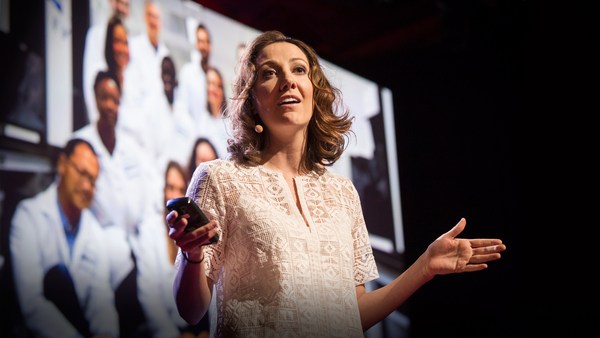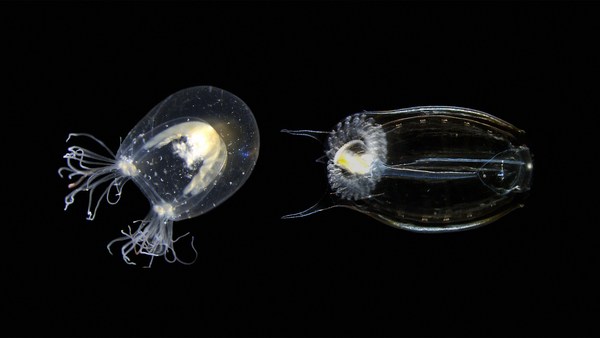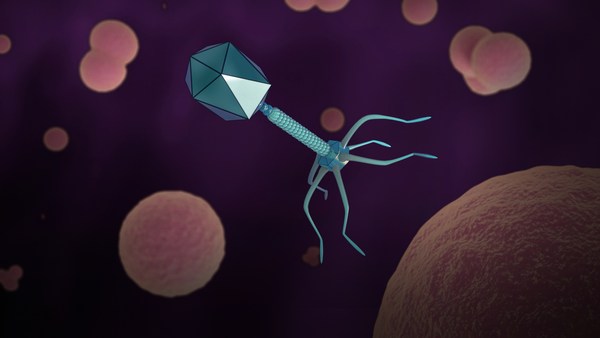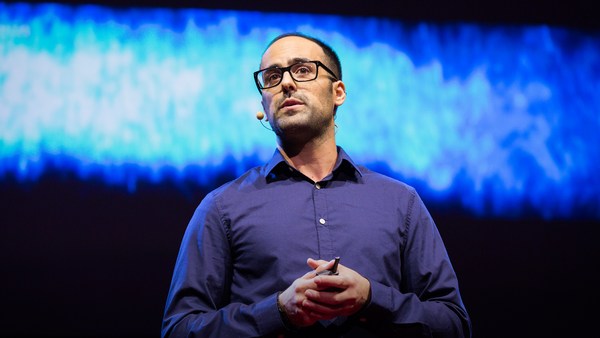So ... we're in a real live war at the moment, and it's a war that we're truly losing. It's a war on superbugs.
So you might wonder, if I'm going to talk about superbugs, why I'm showing you a photograph of some soccer fans -- Liverpool soccer fans celebrating a famous victory in Istanbul, a decade ago. In the back, in the red shirt, well, that's me, and next to me in the red hat, that's my friend Paul Rice. So a couple of years after this picture was taken, Paul went into hospital for some minor surgery, and he developed a superbug-related infection, and he died. And I was truly shocked. He was a healthy guy in the prime of life. So there and then, and actually with a lot of encouragement from a couple of TEDsters, I declared my own personal war on superbugs.
So let's talk about superbugs for a moment. The story actually starts in the 1940s with the widespread introduction of antibiotics. And since then, drug-resistant bacteria have continued to emerge, and so we've been forced to develop newer and newer drugs to fight these new bacteria. And this vicious cycle actually is the origin of superbugs, which is simply bacteria for which we don't have effective drugs. I'm sure you'll recognize at least some of these superbugs. These are the more common ones around today.
Last year, around 700,000 people died from superbug-related diseases. Looking to the future, if we carry on on the path we're going, which is basically a drugs-based approach to the problem, the best estimate by the middle of this century is that the worldwide death toll from superbugs will be 10 million. 10 million. Just to put that in context, that's actually more than the number of people that died of cancer worldwide last year. So it seems pretty clear that we're not on a good road, and the drugs-based approach to this problem is not working.
I'm a physicist, and so I wondered, could we take a physics-based approach -- a different approach to this problem. And in that context, the first thing we know for sure, is that we actually know how to kill every kind of microbe, every kind of virus, every kind of bacteria. And that's with ultraviolet light. We've actually known this for more than 100 years. I think you all know what ultraviolet light is. It's part of a spectrum that includes infrared, it includes visible light, and the short-wavelength part of this group is ultraviolet light. The key thing from our perspective here is that ultraviolet light kills bacteria by a completely different mechanism from the way drugs kill bacteria. So ultraviolet light is just as capable of killing a drug-resistant bacteria as any other bacteria, and because ultraviolet light is so good at killing all bugs, it's actually used a lot these days to sterilize rooms, sterilize working surfaces.
What you see here is a surgical theater being sterilized with germicidal ultraviolet light. But what you don't see in this picture, actually, is any people, and there's a very good reason for that. Ultraviolet light is actually a health hazard, so it can damage cells in our skin, cause skin cancer, it can damage cells in our eye, cause eye diseases like cataract. So you can't use conventional, germicidal, ultraviolet light when there are people are around. And of course, we want to sterilize mostly when there are people around. So the ideal ultraviolet light would actually be able to kill all bacteria, including superbugs, but would be safe for human exposure. And actually that's where my physics background kicked into this story.
Together with my physics colleagues, we realized there actually is a particular wavelength of ultraviolet light that should kill all bacteria, but should be safe for human exposure. That wavelength is called far-UVC light, and it's just the short-wavelength part of the ultraviolet spectrum. So let's see how that would work. What you're seeing here is the surface of our skin, and I'm going to superimpose on that some bacteria in the air above the skin. Now we're going to see what happens when conventional, germicidal, ultraviolet light impinges on this. So what you see is, as we know, germicidal light is really good at killing bacteria, but what you also see is that it penetrates into the upper layers of our skin, and it can damage those key cells in our skin which ultimately, when damaged, can lead to skin cancer.
So let's compare now with far-UVC light -- same situation, skin and some bacteria in the air above them. So what you're seeing now is that again, far-UVC light's perfectly fine at killing bacteria, but what far-UVC light can't do is penetrate into our skin. And there's a good, solid physics reason for that: far-UVC light is incredibly, strongly absorbed by all biological materials, so it simply can't go very far. Now, viruses and bacteria are really, really, really small, so the far-UVC light can certainly penetrate them and kill them, but what it can't do is penetrate into skin, and it can't even penetrate the dead-cell area right at the very surface of our skin. So far-UVC light should be able to kill bacteria, but kill them safely.
So that's the theory. It should work, should be safe. What about in practice? Does it really work? Is it really safe? So that's actually what our lab has been working on the past five or six years, and I'm delighted to say the answer to both these questions is an emphatic yes. Yes, it does work, but yes, it is safe. So I'm delighted to say that, but actually I'm not very surprised to say that, because it's purely the laws of physics at work.
So let's look to the future. I'm thrilled that we now have a completely new weapon, and I should say an inexpensive weapon, in our fight against superbugs. For example, I see far-UVC lights in surgical theaters. I see far-UVC lights in food preparation areas. And in terms of preventing the spread of viruses, I see far-UVC lights in schools, preventing the spread of influenza, preventing the spread of measles, and I see far-UVC lights in airports or airplanes, preventing the global spread of viruses like H1N1 virus.
So back to my friend Paul Rice. He was actually a well-known and well-loved local politician in his and my hometown of Liverpool, and they put up a statue in his memory in the center of Liverpool, and there it is. But me, I want Paul's legacy to be a major advance in this war against superbugs. Armed with the power of light, that's actually within our grasp.
Thank you.
(Applause)
Chris Anderson: Stay up here, David, I've got a question for you.
(Applause)
David, tell us where you're up to in developing this, and what are the remaining obstacles to trying to roll out and realize this dream?
David Brenner: Well, I think we now know that it kills all bacteria, but we sort of knew that before we started, but we certainly tested that. So we have to do lots and lots of tests about safety, and so it's more about safety than it is about efficacy. And we need to do short-term tests, and we need to do long-term tests to make sure you can't develop melanoma many years on. So those studies are pretty well done at this point. The FDA of course is something we have to deal with, and rightly so, because we certainly can't use this in the real world without FDA approval.
CA: Are you trying to launch first in the US, or somewhere else?
DB: Actually, in a couple of countries. In Japan and in the US, both.
CA: Have you been able to persuade biologists, doctors, that this is a safe approach?
DB: Well, as you can imagine, there is a certain skepticism because everybody knows that UV light is not safe. So when somebody comes along and says, "Well, this particular UV light is safe," there is a barrier to be crossed, but the data are there, and I think that's what we're going to be standing on.
CA: Well, we wish you well. This is potentially such important work. Thank you so much for sharing this with us. Thank you, David.
(Applause)





